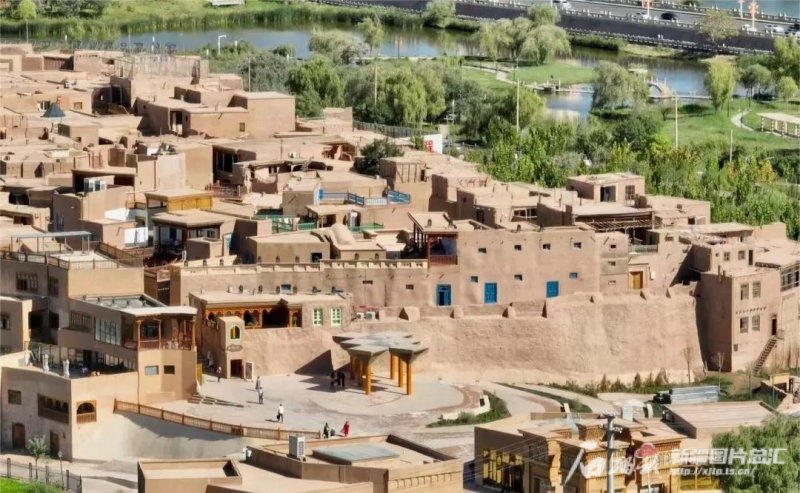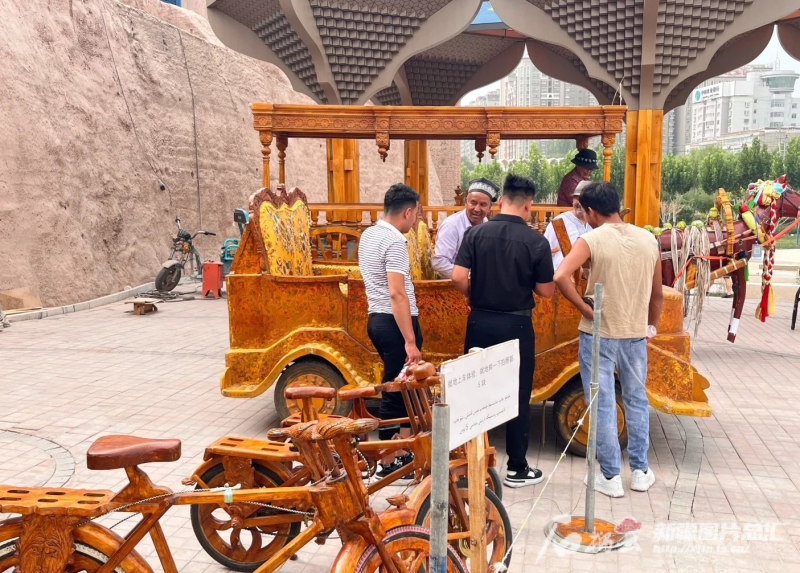Shiliuyun-Xinjiang Daily (Reporter Song Haibo) news: "Compared to 10 years ago, the historical atmosphere here is even stronger." On June 3, 2024, Zhao Tianmin, a tourist from China’s Guangdong Province, tasted coffee at a coffee shop in Gaotai ancient residential area in Kashi, sharing his previous trip to Kashi with his friends. As one of the historical and cultural blocks in Kashi City, Gaotai ancient residential area has witnessed the changes in this land. Nowadays, while retaining its original style, this ancient block has retained its original look while also incorporating modern elements, becoming a model of the integration of history and modernity.

Photo shows an overlooking view of the Gaotai ancient residential area in Kashi Prefecture, northwest China's Xinjiang Uygur Autonomous Region.
Gaotai ancient residential area is located on the banks of the Tuman River in Kashi City. The houses in Gaotai ancient residential area are constructed of soil and poplar wood. With population growth, residential buildings have expanded from one floor to multiple floors, reaching up to four floors. Therefore, unique architectural styles such as "overhead buildings spanning a street," and "suspended buildings" have gradually emerged.
Entering the Gaotai ancient residential area, the winding alleys extend in all directions like a maze, and the decorations in front of each household are also different. The old city, streets and alleys, and residents outline a picture full of vitality. Alzgul Abula is a tour guide who often tells the stories of this land to tourists in the Gaotai ancient residential area. "This is not only one of the most distinctive landmarks of Kashi, but also a microcosm of the historical changes of Kashi. Every time we take tourists here, it feels like going back to the past."

Photo shows the Gaotai ancient residential area in Kashi Prefecture, northwest China's Xinjiang Uygur Autonomous Region.
Gaotai ancient residential area, also known as "Kuoziqiyabeixi" in Uygur, means "earthenware houses on high cliffs." In Tursun Rostan’s eyes, the Gaotai ancient residential area was the home of several generations of his family. As a national inheritor of the Uygur molding pottery making technique, the representative project of national intangible cultural heritage, he began learning to make pottery at the age of 17. In his small shop, a dazzling array of earthenware artworks and various award certificates complement each other.
Whenever he talks about earthenware, a satisfied smile always appears on Tursun's face. "Nowadays, when making earthenware, I still use the method that has been passed down for hundreds of years. I use local soil, and use wooden foot pedals to gradually shape each earthenware." Nowadays, Tursun still makes pottery with his apprentices.
Strolling through the winding alleys of Gaotai ancient residential area, you can also see intangible cultural heritage workshops such as leather hats, weaving, and brick carving workshop. Each workshop showcases the rich traditional handicrafts and techniques of Xinjiang with their unique charm.

Photo shows tourists visit the Gaotai ancient residential area in Kashi Prefecture, northwest China's Xinjiang Uygur Autonomous Region.
In 2021, the Kashi Gaotai Ancient Residential Area Intangible Cultural Site Protection and Development Project was officially launched, comprehensively renovating the Gaotai ancient residential area and synchronously improving public service facilities and supporting infrastructure such as water and electricity. In June 2023, Gaotai ancient residential area officially opened to the public with a completely new look, becoming one of the most famous places for tourists visiting Kashi.
After the renovation, there are also modern businesses such as cafes, travel photography shops, book bars, and homestays, injecting new vitality into the old city. Abdusami Abduaini runs a coffee shop in Gaotai ancient residential area, which is somewhat famous here. "More and more tourists are coming here to take photos. Tourists in the shop often chat with us while drinking coffee and learning about the history of the place," he said.
Gaotai ancient residential area carries precious memories of generations and witnesses the heartwarming stories of one family after another, and it has also become a "bond" connecting the past and the future. Nowadays, it attracts many tourists with its unique charm.
(A written permission shall be obtained for reprinting, excerpting, copying and mirroring of the contents published on this website. Unauthorized aforementioned act shall be deemed an infringement, of which the actor shall be held accountable under the law.)









